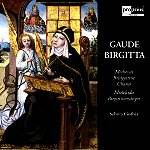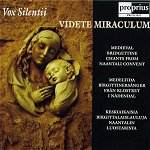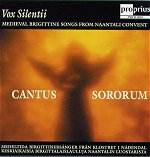Now
the first thing to say is that there
are two St. Bridgets: of Ireland c.525
Feast day February 1st and
this St. Bridget, of Sweden (1303-73)
whose Feast day is July 23rd foundress
and visionary, patron of Sweden. She
founded a monastery in 1346 at Vadstena
on Lake Vattern for sixty nuns and twenty-five
monks who lived separately. In temporal
matters the abbess was supreme; in spiritual
ones the monks.
These
three CDs (all available separately
but grouped here for convenience) consist
entirely of chant associated with the
Swedish St. Bridget. To be precise they
come from a collection she commissioned
and contributed to, entitled ‘Cantus
Sororum’. This book was essential to
the life of the Convent for it contained
chants for each morning service of the
week. Not only did it contain chants
but also readings and sermons - all
for daily use. Hilkk-Liisa Vuori tells
us in her booklet notes for CD3 that
they consist of "Hymns, antiphons
and responsories". All forms are
represented here.
The
Antiphons are songs "framed by
recitation from the book of psalms which
are sung after the bible reading".
One, (‘Rosa rorans bonitatem’ on CD
1) is by Nils Hermansson, Bishop of
Linkoping (died 1391). Some are by Magister
Petrus, a colleague of St. Bridget.
There are also sequences which belong
to the Mass "and often consist
of pairs of verses that are sung antiphonally.
Normally these are performed on Major
Feast days" (Alf Hardelin’s notes
in booklet of CD1).
These
pieces are all in praise of the virtues
of the Virgin Mary whom Bridget revered.
"Each
day had its own theme. Monday mornings
reflected on Angelic choirs rejoicing
in the Virgin, Tuesday, the focus was
on patriarchs and prophets who foretold
the birth of Mary. On Wednesday, the
people rejoice in the immaculate conception
of the virgin" etc (Hilkka-Liisa
Vuori, a member of Vox Silentii, in
notes on CD3).
It is
a general misconception that most medieval
music is polyphonic. Most certainly
it was not. Here we have a lavish and
vast collection of 14th Century
music dating from a period when Machaut
was writing his Mass and the ‘ars subtlior’
was taking hold, which has no polyphony
at all but is simply chant. St. Bridget
insisted that this music should be performed
"in the spirit of prayer songs
… a seamless entity in which the melody
carries the text". Also with "a
full heart and ardent desire, yet with
humility". In my view this is very
well achieved by both groups.
One
hears on these CDs the chants performed,
as the booklet says "in the same
place in which they were sung by the
Armolaakso (Valley of Grace) sisters
in the Middle Ages. It is enchanting
to think that the church must have sounded
almost exactly the same (for the recording)
as it did in the 15th Century."
(Notes in CD2).
For
my taste the three singers of Vox Silentii
are recorded too closely. Although the
building still has a part to play and
the clarity of the text is superb, there
is an over-pronunciation of certain
consonants, like Ls and Ss
which is rather annoying. Nevertheless
the atmosphere the singers create seems
to be ideal for the exigencies of Bridgettine
early morning services.
Schola
Gothia consists of four voices. They
are gentler with consonants and are
given more space around them. They also
move the chant along more quickly which
is preferable. There is less silence
between phrases. Their approach one
might say is more conventional. Vox
Silentii has a more meditative approach
certainly; their renditions, however,
appear more uneven and sometimes disjointed.
Schola Gothia, it seems to me, are preferable
for more day to day listening. Also
they vary the dynamics with more regularity.
Thinking liturgically these points do
not necessarily matter, but Schola Gothia
is better able to keep my attention.
This is particularly noticeable in the
two renderings of ‘Videte Miraculum’.
Vox Silentii are slower, freer and more
relaxed but the lines do not flow easily
into each other. Schola Gothia makes
more sense of the overall structure
of the chant.
Vox
Silentii use solo lines from time to
time. Also occasionally they have added
drones (not actually approved by St.
Bridget) as in the opening Ave Maria
(CD3). This gives textural variety for
which I, for one, was grateful.
You
might feel that you know some of the
melodies. For example ‘Rogatus Deus
compere’ (a hymn in honour of the birth
of Jesus) is mainly known as the holy
week chant ‘Vexilla Regis’. This is
also a piece in which a drone is used,
mostly under the melody but also, particularly
beautifully, in the upper voice, gently
holding a note as it emerges from the
chant. The ‘Salve Regina’ which ends
CD 3 is a version of the standard chant
by the 8th Century monk,
Adnemar. It is in the collection because
it is appropriate to the idea of the
compassion of the Virgin towards mankind
in the birth of Christ. Therefore both
of these chants are suitable for the
theme of Thursday’s prayers in which
the nuns gave thanks for the birth of
Christ.
‘Rubens
Rosa’ and ‘Errorum pleno tenebrus 'may
be recognized more as the evening chant
‘Christe qui lux’. The latter reminds
us that at the birth of Mary "a
light emerges from the womb of her mother."
This is therefore a suitable prayer
for the Wednesday morning service.
If only
one CD is possible then I would chose
Schola Gothia but there is a down-side
of course.
There
is a helpful translated essay and a
coloured photograph of the manuscript.
The texts are given in Latin but translated
only into Swedish. Vox Silentii supply
some even more interesting essays and
have the Latin texts translated into
English. Considering that these three
CDs come from the same company this
shows a curious inconsistency on their
behalf.
However
for any lover of early chant at least
one of these discs would make a wonderful
Christmas present.
Gary
Higginson


